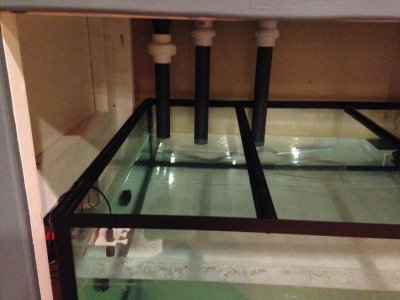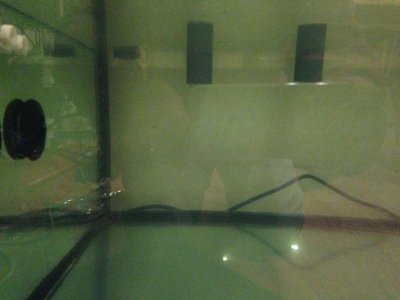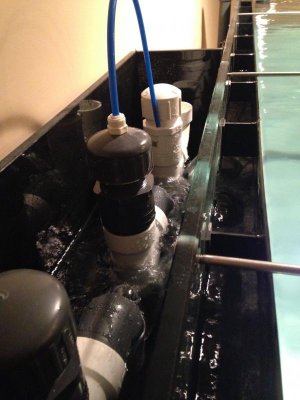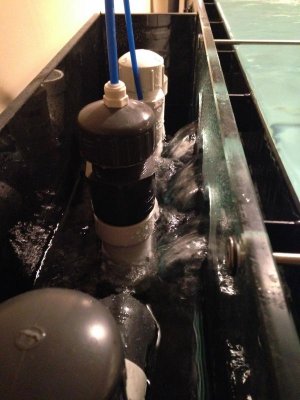You are using an out of date browser. It may not display this or other websites correctly.
You should upgrade or use an alternative browser.
You should upgrade or use an alternative browser.
Silent and Failsafe Overflow System
- Thread starter JohnL
- Start date
Alright, after some trial and error, I think I have it working well. See the attached pic.
My only problem now is the noise from the water cascading into the external overflow. I think I can solve this noise issue if I raise the water level and bean animal standpipes.
What do you think?
My only problem now is the noise from the water cascading into the external overflow. I think I can solve this noise issue if I raise the water level and bean animal standpipes.
What do you think?
Attachments
uncleof6
Active member
Alright, after some trial and error, I think I have it working well. See the attached pic.
My only problem now is the noise from the water cascading into the external overflow. I think I can solve this noise issue if I raise the water level and bean animal standpipes.
What do you think?
Yes you can. Run the water level around the centerline of the through holes, per the layout image I have posted numerouse times in this thread. You want the water level the same in both the internal and external box, thus eliminating the waterfall to the external. You can see the channeling in the through holes, so the system could benefit from more through holes as well... probably too late for that.
You should be using a non-hardening thread sealant on all PVC threaded connections.
Can you please provide an example that could be bought on amazon or lowes/home depot or a similar common store?
Always concerned about choosing something that may not be reef safe.
woodnaquanut
Active member
Can you please provide an example that could be bought on amazon or lowes/home depot or a similar common store?
Always concerned about choosing something that may not be reef safe.
Uncle, bless his heart, is kind of a 'only the right way' kind of guy. There are millions of PVC connections done with tape. They work and will hold water till the end of time.
Even in the Spears video on how to make a connection, they talk about using teflon tape. It's not their preferred method, but it does work.
I have not been able to find the Spears product locally at any BB store. I've used teflon tape for years. Just be real careful not to over tighten. Spears recommends finger tight plus one to two complete turns.
See:
http://youtu.be/Auyhm7YKQEI
Spaced Cowboy
South Bay Reefer
You want the inlets to the downturned elbows around 3/4" up from the bottom of the overflow, and the water line in the overflow (running) just below the tops of the elbows.
Personally, I don't think your plan is "safe" in terms of the plumbing hanging off the back of an overflow, hanging off the back of the tank. That plumbing should go out the bottom of the overflow box, with the plumbing well secured to the stand, to help support everything. In this case you may well need the whole 7" of the overflow depth, I am not certain of 10" however, as i don't have hands on the system.
So, I've reworked the drain pipes a bit, to take into account your concerns - it'll also give me more work-space at the back of the tank, which is good. Here's a newer illustration

Nothing but 45's, albeit in 2 dimensions. The main siphon is the one with the least amount of non-vertical run. Those are also sanitary T's, although it's not obvious from the image.
I'm still using a 7" deep external overflow, although it runs with ~1.25" of clearance beneath the downturned elbows. Is there any point in putting pipe in there to get that down to the 3/4" that you were talking about ? Or is 1.25" not going to be an issue ?
The return pump will be putting over 1500 gpm through the tank (somewhere between 2000 and 2500 gpm in fact, depending on how much I lose due to friction), so I'm guessing that the larger separation won't be an issue.
Simon
Can you please provide an example that could be bought on amazon or lowes/home depot or a similar common store?
Always concerned about choosing something that may not be reef safe.
this is what I used from Lowes.
http://www.lowes.com/pd_45368-72720-23631_0__?productId=1087359
uncleof6
Active member
Can you please provide an example that could be bought on amazon or lowes/home depot or a similar common store?
Always concerned about choosing something that may not be reef safe.
http://www.customaquatic.com/estore/control/product/~product=PF-SPSB75-005
Uncle, bless his heart, is kind of a 'only the right way' kind of guy. There are millions of PVC connections done with tape. They work and will hold water till the end of time.
Even in the Spears video on how to make a connection, they talk about using teflon tape. It's not their preferred method, but it does work.
I have not been able to find the Spears product locally at any BB store. I've used teflon tape for years. Just be real careful not to over tighten. Spears recommends finger tight plus one to two complete turns.
See:
http://youtu.be/Auyhm7YKQEI
The simple point is: tape distorts the threaded fittings, it does not matter how little you put on it. It was intended for iron pipe to prevent galling, it is not an "every threaded fitting's" magic cure. I really don't see the logic or benefit of telling folks something other than the "right way" or "best way" to do something. It just keeps up the confusion with all of this. I know it is not easy to get away from telling people what they want to hear, whether it is right or wrong.
Last edited:
uncleof6
Active member
So, I've reworked the drain pipes a bit, to take into account your concerns - it'll also give me more work-space at the back of the tank, which is good. Here's a newer illustration

Nothing but 45's, albeit in 2 dimensions. The main siphon is the one with the least amount of non-vertical run. Those are also sanitary T's, although it's not obvious from the image.
I'm still using a 7" deep external overflow, although it runs with ~1.25" of clearance beneath the downturned elbows. Is there any point in putting pipe in there to get that down to the 3/4" that you were talking about ? Or is 1.25" not going to be an issue ?
The return pump will be putting over 1500 gpm through the tank (somewhere between 2000 and 2500 gpm in fact, depending on how much I lose due to friction), so I'm guessing that the larger separation won't be an issue.
Simon
You can reduce the space between lines by switching around the open channel and dry emergency. The more equal the runs are the better.
Personally, I don't think it is worth adding pipe to the elbows...
woodnaquanut
Active member
The simple point is: tape distorts the threaded fittings, it does not matter how little you put on it. It was intended for iron pipe to prevent galling, it is not an "every threaded fitting's" magic cure. I really don't see the logic or benefit of telling folks something other than the "right way" or "best way" to do something. It just keeps up the confusion with all of this. I know it is not easy to get away from telling people what they want to hear, whether it is right or wrong.
I'm not looking for nor have I advocated for a magic cure. Tape or sealant won't cure stupid/inept. Either applied incorrectly will be trouble. Either applied correctly will be successful.
My point is there can be many more that one way to do something that ends up with perfectly acceptable results. Since the Spears vid doesn't say, "Don't use tape", I'll assume it's OK. What is not OK is over tightening.
Are you disputing Spears info? If you do, how can you accept the first half (thread sealant) of the video?
I'm not telling people what they want to hear. I'm repeating and referencing what the real expert, the manufacturer, recommends.
uncleof6
Active member
I'm not telling people what they want to hear. I'm repeating and referencing what the real expert, the manufacturer, recommends.
So am I. Should only take 5 seconds to figure out why there is a contradiction:
http://lascofittings.sitewrench.com/threads
It should only take 5 seconds, but it will likely not happen, as everyone has to be right, people have done it "this way" for years, so it has to be right. Put simply, one is true and the other one isn't. It will take much longer becasue the next level will be "it is ok to use tape on Spears fittings, but not on Lasco fittings." Also I am certain there will an effort to find a contradiction in Lasco's information as well.:deadhorse:
woodnaquanut
Active member
So am I. Should only take 5 seconds to figure out why there is a contradiction:
http://lascofittings.sitewrench.com/threads
It should only take 5 seconds, but it will likely not happen, as everyone has to be right, people have done it "this way" for years, so it has to be right. Put simply, one is true and the other one isn't. It will take much longer becasue the next level will be "it is ok to use tape on Spears fittings, but not on Lasco fittings." Also I am certain there will an effort to find a contradiction in Lasco's information as well.:deadhorse:
:deadhorse: indeed! Whip it, whip it good!!
Good article. The one place I feel it falls short is actually saying what sealants will work. To quote the article, "Several sealants on the market meet all these requirements."
Spears and Lasco seem to have different opinions. Perhaps we could also have different opinions and neither of us be wrong?
I'm NOT saying because it's been done this way it's right, I'm saying because it's been done successfully for years, it will work just fine.
The key to all this is DO NOT OVER TIGHTEN! Of Lasco's six bullet points, three talk about the dangers of over tightening.
I worry about sending a rookie 'plumber' off to find a sealant. The proper sealant doesn't seem to exist in normal retail outlets. I feel the chance something either toxic or incompatible will be used is higher than when using tape.
hbash
New member
:deadhorse: indeed! Whip it, whip it good!!
Good article. The one place I feel it falls short is actually saying what sealants will work. To quote the article, "Several sealants on the market meet all these requirements."
Spears and Lasco seem to have different opinions. Perhaps we could also have different opinions and neither of us be wrong?
I'm NOT saying because it's been done this way it's right, I'm saying because it's been done successfully for years, it will work just fine.
The key to all this is DO NOT OVER TIGHTEN! Of Lasco's six bullet points, three talk about the dangers of over tightening.
I worry about sending a rookie 'plumber' off to find a sealant. The proper sealant doesn't seem to exist in normal retail outlets. I feel the chance something either toxic or incompatible will be used is higher than when using tape.
Custom Aquatics has the Spears Non Hardening Thread Sealant which has been blessed by Mr. U6 as the stuff to use and I have purchased and begun using this. Plus after that lasco article discussing why to not use the tape and how the sealant oozes into the threads to make a better seal, I would think discussion on that is over and we all have learned something to incorporate into our projects going forward. Thank you Mr. U6.
uncleof6
Active member
:deadhorse: indeed! Whip it, whip it good!!
Good article. The one place I feel it falls short is actually saying what sealants will work. To quote the article, "Several sealants on the market meet all these requirements."
Spears and Lasco seem to have different opinions. Perhaps we could also have different opinions and neither of us be wrong?
I'm NOT saying because it's been done this way it's right, I'm saying because it's been done successfully for years, it will work just fine.
The key to all this is DO NOT OVER TIGHTEN! Of Lasco's six bullet points, three talk about the dangers of over tightening.
I worry about sending a rookie 'plumber' off to find a sealant. The proper sealant doesn't seem to exist in normal retail outlets. I feel the chance something either toxic or incompatible will be used is higher than when using tape.
You really do not see why Spears is contradicting Lasco? Spears is not recommending tape in general, they are recommending THEIR brand of tape... the one they sell... they one they want to make money off of, because no matter how many say this or that, the bottom line is they want to sell the stuff. They have a marketing strategy... guess what? It is working.
Lasco sells neither... so who has something to gain with a marketing strategy; which has nothing to lose by telling it the way it is?
This is the same as the big "primer debate," which is easily solved by reading the instructions on the can of glue: "use primer IF required." The glue manufacturers were ones that pushed the "primer" code legislation, why? They could not sell any primer, why? It was not required. Now codes require it on pipes 4" diamter and larger. Another case where primer might be "required" is on pipe that has been buried for years...
As far as rookie plumbers go, I doubt they have any notion of what to do with the tape, any more than they know which thread sealant to use. That is what education is for, that is why I post the information, presented as it is. It is the pro plumbers that messed it all up in the first place...
This is the wrong thread to continue this. This thread is about a drain system.
Last edited:
uncleof6
Active member
As my elbows won't be close to the bottom of the overflow box and I prefer not to send my critters on a water slide ride, I have been looking into alternatives for strains:

Mr. U6, does this make sense?
Not really, because instead of going down the drain, and MAYBE occuluding the line and dying, the innocent lil critter will get sucked up against the strainer, and will certainly die. Although you may notice a "problem" with the drain system and free the critter before he croaks, you may not. Marine animals are not generally surface feeders unless you train them to be, so they are not just going to run up to the surface for a look see/jump out of the water, for no reason at all. Though some have a "reputation" for jumping out, the main reason fish jump, is seldom mentioned: looking for better conditions than they are currently in. One of the major contributors is low oxygen levels. Not mentioning this, relieves the hobbyist's responsibility.
Spaced Cowboy
South Bay Reefer
You can reduce the space between lines by switching around the open channel and dry emergency. The more equal the runs are the better.
At first, I didn't really get what you were trying to say, I had to read it a dozen or so times, then the lightbulb went on... Here's what it looks like now:

... which looks a lot neater than before...
Thanks for all the advice
Simon
uncleof6
Active member
At first, I didn't really get what you were trying to say, I had to read it a dozen or so times, then the lightbulb went on... Here's what it looks like now:

... which looks a lot neater than before...
Thanks for all the advice
Simon
Welcome. After it is all said and done, I am here to help.
Similar threads
- Replies
- 2
- Views
- 717
- Replies
- 2
- Views
- 296




